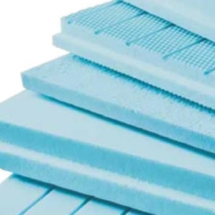1. XPS NEDİR
Homojen hücre yapısına sahip, ısı yalıtımı yapmak amacıyla üretilen ve kullanılan köpük malzemelerdir. XPS’in hammaddesi olan polistren, ekstrüzyon işlemi ile hat boyunca istenilen kalınlıkta çekilir. Sürekli bilgisayar kontrolünde yapılan bu üretim sayesinde homojen balpeteği görünümünde, kararlı bir hücre yapısı elde edilir. Hücreler bütün yüzlerinden birbirine bağlıdır. Hava hücrelerin içine hapsedilmiştir. Hareketsiz kuru hava ile; bilinen en mükemmel ısı yalıtımı sağlanmaktadır.
Hattan çıkan malzemenin yüzeyi, zırhlı veya pürüzlü yüzey olarak malzemenin kullanılacağı detaydaki ihtiyaçlar doğrultusunda yapılandırılır.
Bu yapı sayesinde Ekstrude Polistren malzemeler (XPS) bünyesine su almaz ve nemden etkilenmezler ve diğer ısı yalıtım malzemeleri ile kıyaslandığında haklı bir üstünlüğe sahiptirler.
XPS’İN ÜSTÜN ÖZELLİKLERİ:
• Düşük ısı iletkenlik değeri.
• Su emmeme özelliği sayesinde sürekli ve azalmayan λ- ısı iletkenlik değeri.
• Dona karşı dayanım.
• Yüksek basma ve eğilme mukavemeti sayesinde zaman içinde kalınlığı azalmaz.
• Yüksek elastizite modülü ve boyutsal kararlılık.
• Optimum buhar difüzyon direnci sayesinde kullanım yerine uygun µ değeri.
• XPS ürünler diğer plastiklerle karıştırılmadan geri dönüşümde kulanılabilir.
• Her çeşit kesici aletle kesilebilir,ufalanmaz, fire vermez.
• Kapalı Gözenekli Hücre Yapısına Sahiptir.
2. XPS TARİHÇESİ
İlk Ekstrüde Polistren Köpük 1940’lı yılların başında, Amerika’da askeri amaçlı talep üzerine yüzer sallar için üretilmiştir. Yoğun kullanımı sonucunda, su ve neme karşı oldukça dirençli olduğu fark edilen bu ürünlerin aynı zamanda ısı yalıtım teknik özelliklerinin farkına varılmıştır ve ısı yalıtımı amacıyla üretimine devam edilmiştir. 1960’lı yıllarda ise Avrupa’da üretimine başlanan Ekstrüde Polistren Köpükler, 50 yılı aşkın bir süredir de tüm binalarda ve mühendislik yapılarında güvenle kullanılmaktadır. Bugün Ekstrüde Polistren Köpüklerin tüm dünyadaki kullanımı 15-20 milyon m3 / yıl civarındadır.
Türkiye’de yerli üretim 1994 yılında başlamıştır.2005 yılında toplam üretim 700.000 m3 / yıl iken 2008 yılında 1.600.000 m3 / yıl’ın üzerindedir. İnşaat sektöründeki büyümeye paralel olarak yıllık yaklaşık % 15-20 Pazar büyümesi gerçekleşmektedir. 2012 yılı Pazar büyüklüğü yaklaşık 3 milyon m3’ün üzerindedir.
3. XPS NASIL ÜRETİLİR
Homojen hücre yapısına sahip, ısı yalıtımı yapmak amacıyla üretilen ve kullanılan köpük malzemelerdir. XPS hammaddesi polistren, bir şişirme ajanı yardımı ile sürekli bir ekstrüzyon işlemi vasıtasıyla sabit basınç altında köpük halinde üretilir. Kapalı hücre yapısına sahip levha haline getirilmiş ürün kullanım yerine uygun olarak yüzey işlemesine tabi tutulur.
Üretimi sırasında işlem parametrelerinin varyasyonu ile çeşitli uygulama gereksinimlerini karşılamak üzere XPS ürün özelliklerinin değişikliğine izin verir. Köpük yoğunluğu ( 20-50 kg/m3) ile basınç mukavemeti değerleri (100-500 kPa) elde edilebilir. Isı iletkenlik hesap değeri 0.030-0.035-0,040 gruplarında üretilir.
4. XPS KALİTE
Avrupa topluluğu içinde inşaat sektöründe CPD (Construction Product Directive) Türkiyede de Yapı Malzemeleri Yönetmeliği gereğince inşaat sektöründe kullanılan kullanılan XPS ısı yalıtım levhalarının CE işareti taşıması gerekir. TS EN 13164’e uygun olarak belirtilen ürün test frekansları ile CE işareti başlangıç tip deneyi (ITT) ve fabrika üretim kontrolü (FPC) için gereksinimleri karşılamak için üretici tarafından uygulanması gerekmektedir.



